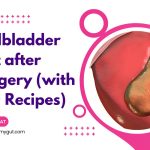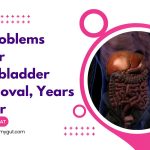5 Gallbladder Symptoms in Men& When to Worry (Doctor Explains).
Our content is not intended nor recommended as a substitute for medical advice by your doctor. Use for informational purposes only.
Gallbladder symptoms in men commonly develop due to gallstones. Gallbladder pain in men can mimic other abdominal conditions such as peptic ulcer pain and irritable bowel syndrome.
In this article, you will learn the characteristic symptoms of gallbladder disease in men.
Common gallbladder symptoms in men include:
- Right upper quadrant pain that may radiate to the back.
- Severe attacks of nausea after eating.
- Bloating and fullness after eating.
- Vomiting.
- Diarrhea.
- Complicated gallbladder disease symptoms in men include fever, severe upper right abdominal pain, and maybe jaundice.
Table of Contents
1. Pain (in attacks).
Gallstones are the most common cause of gallbladder symptoms (pain). However, most gallstones are asymptomatic.
The main gallbladder symptom is pain in the upper right abdomen (at the site of the gallbladder).
The pain has distinctive characteristics that set it apart from other causes of upper right abdominal pain, such as liver pain and colon pain.
However, the differentiation between gallbladder pain and other causes can be difficult.
- Gallbladder pain usually comes in sudden attacks (typically after eating a heavy or high-fat meal).
- The attack starts as a constant but severe aching pain in the upper right abdomen.
- The pain starts gradually and builds up to reach its maximum within 10-30 minutes.
- It typically lasts one to two hours (The range is between 30 minutes to 6 hours).
- The pain may radiate to the right back, the right side, and the middle of the stomach.
- During the attack, most patients feel intense nausea, anorexia, and maybe vomiting.
- The attack then resolves gradually.
- Often, You DON’t Experience residual pain in between the attacks.
- The attack may recur at any time (ranging from multiple attacks per day to a single attack every few months or years.
The above description applies to non-complicated gallstone disease (gallstone pain without acute cholecystitis or biliary obstruction.
The exact pain characteristics are described in the table below (reference).
| Biliary colic (Uncomplicated gallstone). | Description |
|---|---|
| 1. Site | Usually, The right upper quadrant of your abdomen |
| 2. Spread | – The pain may spread to the back of the right shoulder.– Also, it spreads to the epigastric area. |
| 3. Character | Constant builds up then disappears gradually. |
| 4. Duration | At least 30 minutes. It may last up to 6 hours. |
| 5. Relation to food | – Triggered by foods (especially fatty food and large meals.– However, it can start spontaneously. |
| 6. NOT related to: | Movement, bowel movements, nor the passage of flatus. |
| 7. Nausea | Often Present, severe. |
| 8- Commonly associated symptoms | Vomiting and sweating during the attack. |
| 9. Unusual symptoms. | – Heartburn and chest pain.– Bloating, fullness.– Early satiety.– Isolated epigastric pain. |
| 10. Symptoms NOT associated: | – Fever.– Jaundice.– Prolonged pain for more than 6 hours.– Extreme tenderness over the gallbladder (Murphy’s sign).– Vomiting of blood, blackish stool (PUD). |
2. Atypical Gallbladder pain locations in men.
A. Right back and right shoulder pain.
The gallbladder pain during the attack may radiate to the right shoulder and back. The pain in these areas can be confused with musculoskeletal pain.
The following characteristics will help you differentiate gallbladder pain in the shoulder and back from other causes:
- Not associated with movement.
- Associated with right upper abdominal pain (co-occur at the same time).
- The right and shoulder pain disappears after the attack resolves.
- Often starts after eating.
- Typically confined to the right shoulder blade, but it can be felt anywhere in the right upper back.
3. Nausea after eating (and vomiting).
Nausea is one of the most common gallbladder symptoms in men. Severe nausea after eating fatty foods can be the first sign of a bad gallbladder.
However, nausea is common with other gut diseases such as Acid reflux, chronic gastritis, peptic ulcer disease, and others. However, it is more intense, happens acutely, and resolves rapidly after the pain resolves (with no residual nausea after the attack).
Nausea is isolated or associated with typical biliary colic (explained below). Isolated intense nausea after eating should raise the suspicion of a bad gallbladder.
If the pain is severe, nausea may lead to vomiting attacks.
4. Bloated and indigestion after eating.
Mild cases of gallstone disease may not present with pain at all. But rather vague symptoms such as indigestion (dyspepsia), bloating, and upper abdominal discomfort after eating.
Unfortunately, these symptoms are subtle and occur with various gastrointestinal conditions, such as peptic ulcer disease, functional dyspepsia, and irritable bowel syndrome.
Of course, you cannot depend on such symptoms to predict gallbladder diseases. But it may take to investigate such symptoms if you experience them over long periods without apparent cause.
5. Diarrhea.
A gallbladder malfunction affects your bowel habits. A common example is bile acid diarrhea, characterized by diarrhea with severe urgency (reference).
Bile acid diarrhea (BAD) is a common disease. Moreover, it is often misdiagnosed as IBS diarrhea, while the cause is bile.
Interestingly, several studies (reference 1, reference 2) found that almost 50% of people with IBS-D (Irritable Bowel Syndrome with Predominant Diarrhea) have Bile Acid Diarrhea (BAD).
So, a change in bowel movements (particularly diarrhea) can be a gallbladder symptom in men.
Learn More about Bile acid diarrhea
6. Symptoms of gallbladder complications in men:
Gallstones often cause intermittent or recurrent attacks of biliary colic (described in the first section).
However, gallstones may lead to one or more of the following complications:
- Acute cholecystitis: acute obstruction and inflammation of the gallbladder that may lead to gallbladder gangrene or rupture.
- Choledocholithiasis: gallbladder stones obstructs the main bile duct leading to jaundice and a severe form of gallbladder pain.
- Gallstone pancreatitis: acute pancreatitis due to the obstruction of the pancreatic duct by a slipped stone from the gallbladder.
The table below illustrates the differences between uncomplicated and complicated gallbladder symptoms in women.
| Typical (uncomplicated) gallbladder pain | Complicated gallbladder pain | |
|---|---|---|
| 1. Site | Usually, The right upper quadrant of your abdomen | The same. |
| 2. Spread | – The pain may spread to the back of the right shoulder.– Also, it spreads to the epigastric area. | The same. |
| 3. Character | Constant. Builds up and then disappears gradually. | The same, but more severe and more prolonged. |
| 4. Duration | At least 30 minutes. It may last up to 6 hours. | It can last more than 6 hours. |
| 5. Relation to food | – Triggered by foods (especially fatty food and large meals.– However, it can start spontaneously. | Often persistent. Regardless of eating. |
| 6. Comes and goes? | Yes | No |
| 7. Nausea, vomiting. | Often Present. | Present, but very severe and persistent. |
| 8. Associated symptoms | – Heartburn and chest pain.– Bloating, fullness.– Early satiety.– Epigastric pain. | The same, but more severe. |
| 9. Fever. | Absent. | Often present. |
| 10. Jaundice | Absent | Present with Bile duct stones. |
| 11. Murphy’s sign (tenderness over the gallbladder area) | Often absent. | Often present. |
- Evidence-based
- Written by a doctor.







